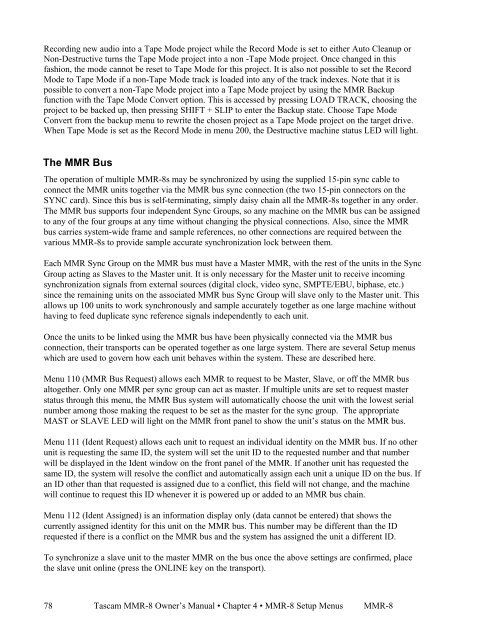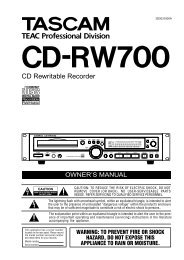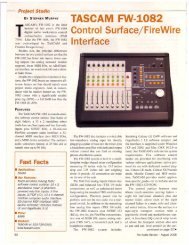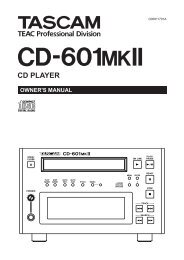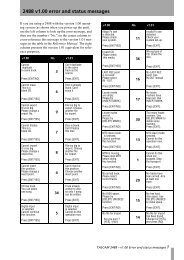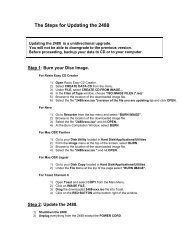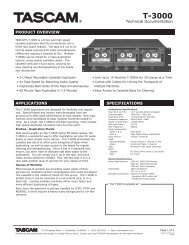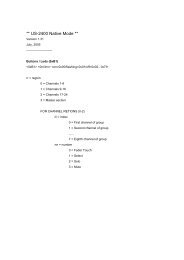Modular Multitrack Recorder - Tascam
Modular Multitrack Recorder - Tascam
Modular Multitrack Recorder - Tascam
Create successful ePaper yourself
Turn your PDF publications into a flip-book with our unique Google optimized e-Paper software.
Recording new audio into a Tape Mode project while the Record Mode is set to either Auto Cleanup or<br />
Non-Destructive turns the Tape Mode project into a non -Tape Mode project. Once changed in this<br />
fashion, the mode cannot be reset to Tape Mode for this project. It is also not possible to set the Record<br />
Mode to Tape Mode if a non-Tape Mode track is loaded into any of the track indexes. Note that it is<br />
possible to convert a non-Tape Mode project into a Tape Mode project by using the MMR Backup<br />
function with the Tape Mode Convert option. This is accessed by pressing LOAD TRACK, choosing the<br />
project to be backed up, then pressing SHIFT + SLIP to enter the Backup state. Choose Tape Mode<br />
Convert from the backup menu to rewrite the chosen project as a Tape Mode project on the target drive.<br />
When Tape Mode is set as the Record Mode in menu 200, the Destructive machine status LED will light.<br />
The MMR Bus<br />
The operation of multiple MMR-8s may be synchronized by using the supplied 15-pin sync cable to<br />
connect the MMR units together via the MMR bus sync connection (the two 15-pin connectors on the<br />
SYNC card). Since this bus is self-terminating, simply daisy chain all the MMR-8s together in any order.<br />
The MMR bus supports four independent Sync Groups, so any machine on the MMR bus can be assigned<br />
to any of the four groups at any time without changing the physical connections. Also, since the MMR<br />
bus carries system-wide frame and sample references, no other connections are required between the<br />
various MMR-8s to provide sample accurate synchronization lock between them.<br />
Each MMR Sync Group on the MMR bus must have a Master MMR, with the rest of the units in the Sync<br />
Group acting as Slaves to the Master unit. It is only necessary for the Master unit to receive incoming<br />
synchronization signals from external sources (digital clock, video sync, SMPTE/EBU, biphase, etc.)<br />
since the remaining units on the associated MMR bus Sync Group will slave only to the Master unit. This<br />
allows up 100 units to work synchronously and sample accurately together as one large machine without<br />
having to feed duplicate sync reference signals independently to each unit.<br />
Once the units to be linked using the MMR bus have been physically connected via the MMR bus<br />
connection, their transports can be operated together as one large system. There are several Setup menus<br />
which are used to govern how each unit behaves within the system. These are described here.<br />
Menu 110 (MMR Bus Request) allows each MMR to request to be Master, Slave, or off the MMR bus<br />
altogether. Only one MMR per sync group can act as master. If multiple units are set to request master<br />
status through this menu, the MMR Bus system will automatically choose the unit with the lowest serial<br />
number among those making the request to be set as the master for the sync group. The appropriate<br />
MAST or SLAVE LED will light on the MMR front panel to show the unit’s status on the MMR bus.<br />
Menu 111 (Ident Request) allows each unit to request an individual identity on the MMR bus. If no other<br />
unit is requesting the same ID, the system will set the unit ID to the requested number and that number<br />
will be displayed in the Ident window on the front panel of the MMR. If another unit has requested the<br />
same ID, the system will resolve the conflict and automatically assign each unit a unique ID on the bus. If<br />
an ID other than that requested is assigned due to a conflict, this field will not change, and the machine<br />
will continue to request this ID whenever it is powered up or added to an MMR bus chain.<br />
Menu 112 (Ident Assigned) is an information display only (data cannot be entered) that shows the<br />
currently assigned identity for this unit on the MMR bus. This number may be different than the ID<br />
requested if there is a conflict on the MMR bus and the system has assigned the unit a different ID.<br />
To synchronize a slave unit to the master MMR on the bus once the above settings are confirmed, place<br />
the slave unit online (press the ONLINE key on the transport).<br />
78<br />
<strong>Tascam</strong> MMR-8 Owner’s Manual • Chapter 4 • MMR-8 Setup Menus MMR-8


